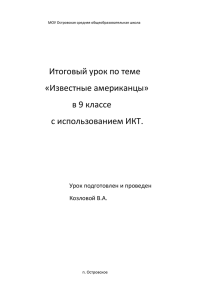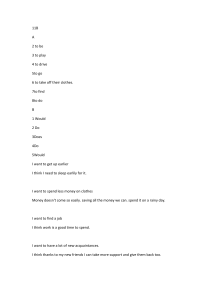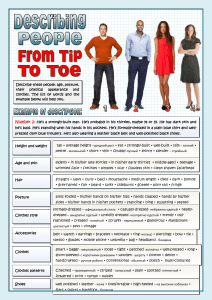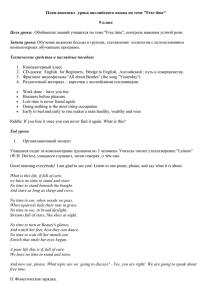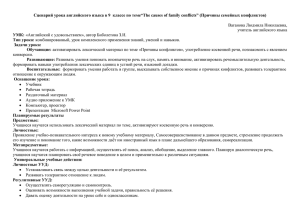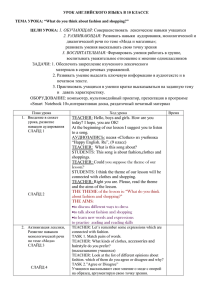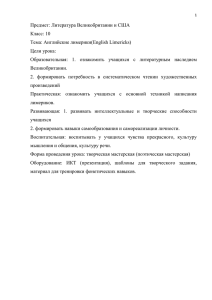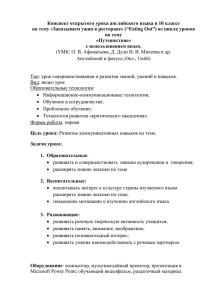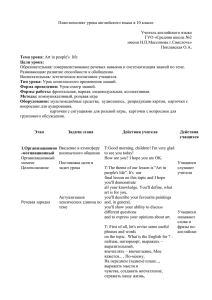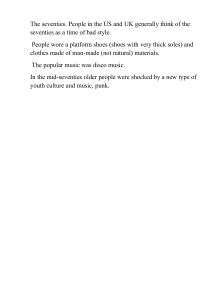Разработка урока по теме What`s in (Unit 2 “Do good clothes open
реклама
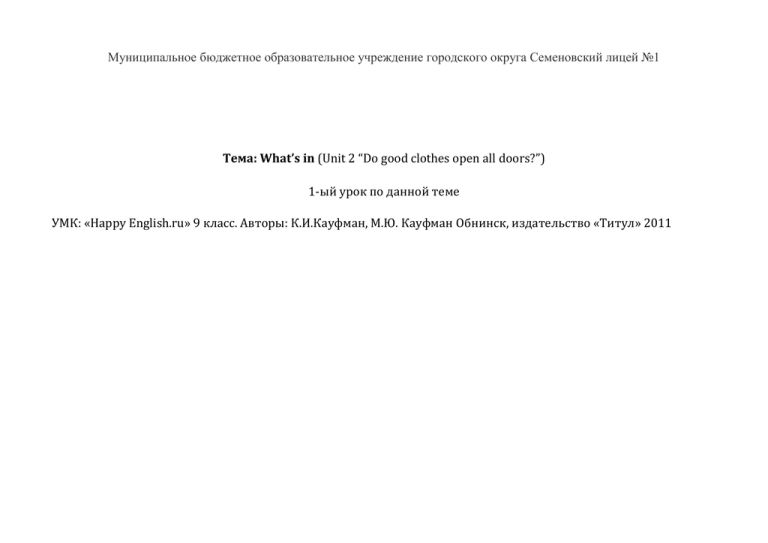
Муниципальное бюджетное образовательное учреждение городского округа Семеновский лицей №1 Тема: What’s in (Unit 2 “Do good clothes open all doors?”) 1-ый урок по данной теме УМК: «Happy English.ru» 9 класс. Авторы: К.И.Кауфман, М.Ю. Кауфман Обнинск, издательство «Титул» 2011 Кирпичникова Наталья Александровна учитель английского языка 2013 год Цель урока: совершенствовать коммуникативную компетенцию учащихся по данной теме. Задачи урока: Образовательная – способствовать формированию лексических навыков (обеспечить в ходе урока усвоение лексики) по теме «Молодежная мода». Воспитательная - способствовать развитию умения отстаивать свою точку зрения; способствовать развитию культуры взаимоотношений при работе в парах, группах, коллективе; Развивающая - создать условия для развития коммуникативных навыков через разнообразные виды речевой деятельности (аудирование, чтение, говорение); создать условия для развития таких аналитических способностей учащихся, как умение анализировать, сопоставлять, сравнивать, обобщать познавательные объекты, делать выводы. Методы обучения: наглядно-иллюстративный, проблемно-поисковый, коллективное осмысление Формы организации познавательной деятельности: фронтальная работа, индивидуальная, работа в парах. Средства обучения: аудиовизуальные (компьютер, медиапроектор, информационные (компоненты УМК ), авторские медиаресурсы (презентация). Оборудование урока: учебники, мультимедийный проектор, презентация. Тип урока: урок комплексного применения знаний с использованием электронно-образовательных ресурсов. УУД: Личностные: – формирование познавательных мотивов обучающихся; – нравственно-этическое оценивание усваиваемого содержания, исходя из социальных и личностных ценностей. Регулятивные: – владение навыками самоанализа и самооценки своей деятельности. Коммуникативные: – продуктивное взаимодействие обучающихся в решении поставленной задачи; – участие в небольших устных высказываниях, «удерживая» логику повествования и предоставление убедительных доказательств; – написание мини-эссе, используя информацию, полученную на уроке. Познавательные: – импровизация, высказывание предположений, обсуждение проблемных вопросов; – самостоятельное создание способов решение проблем поискового характера; Форма урока: Урок формирования лексических навыков. ЯЗЫКОВОЙ МАТЕРИАЛ НОВЫЙ МАТЕРИАЛ МАТЕРИАЛ ДЛЯ ПОВТОРЕНИЯ Лексический материал по теме Повторение ранее изученного лексического «Молодежная мода» материала Этап учебного занятия, время Деятельность учителя Деятельность ученика Используемые электронные 1.Организацион ный момент( 1 минута) 2. Актуализация знаний (1 минута) *Hi, everybody! Glad to see you. I hope you are OK. At least you look nice. I am sure it’s very important to look nice and fashionable. English people say ‘Good clothes open all doors’. Do you agree with me? We, Russians have many proverbs about clothes too. What Russian proverb, do you think has the same meaning? 3. Постановка цели урока, What is in now? What is in fashion with teenagers? Приветствие учителя. Выражение согласия. Учащиеся выбирают близкую по смыслу поговорку. образовательные ресурсы 1 слайд презентации ‘Good clothes open all doors’ (2 слайд) «Наряди пень и пень будет хорош». «По одежке протягивай ножки». «По одежке встречают, по уму провожают» «Не та шинель, что пуговицами блестит, а та, что греет». «В лохмотьях и царя за нищего примут». «В рогожу одеться – от людей отречься» Учащиеся дают варианты: T-shorts, (3 слайд молодежная shirts, jeans, sandals? high мода) hills So, today we are going to speak about what is in with teenagers, fashionable clothes, designers and, of course going shopping. 4. Актуализация We buy clothes in знаний the shops and supermarkets. (ex.2,p.106) There are different opinions about shopping. Учащиеся работают в парах, определяют положительный или отрицательный характер носят высказывания. Suggested Answer Key Read them and decide which of them are positive and which are negative. While reading decide what you think about shopping. Well, let’s see what you have decided. Учитель читает высказывания, And what is your opinion? What do you think about shopping? Добавить учащиеся хором отвечают “positive” или “negative”. Учащиеся высказывают свое отношение к шоппингу, используя (4слайд) На слайде разговорные фразы из упражнения 1 стр 47 учебника. разговорные фразы упр 1. стр 47 5. Первичное восприятие и усвоение нового материала Our friends Emily, Mark, Misha and Rob have different opinions about shopping too. As you remember they are now in New York which is famous for it’s shopping. We are going to listen to them speaking about shopping. But before listening look at ex.1 at page 47, read the words and expressions from the dialogue and repeat them after the speaker. Now listen to Emily, Misha, Rob and Mark and answer the questions: Where are the friends going? Who likes the idea (5 слайд с портретами) Учащиеся слушают и повторяют слова и выражения из диалога. Учащиеся слушают диалог и определяют ответы на вопросы. (6 слайд) Where are the friends going? Who likes the idea of shopping? Who doesn’t like this idea? of shopping? Who doesn’t like this idea? Now tell me where the friends are going? (The friends are going shopping) ? (Misha& Rob) (Mark) Who likes the idea of shopping Who doesn’t like this idea? 6. Отработка лексического материала Now let’s read the dialogue for detail to be able to answer the questions in exercise 4. Read the questions. Don’t forget that more than one answer can be possible. Be ready to support your answer with facts from the dialogue. Учащиеся читают вопросы. Учащиеся читают диалог и отвечают на вопросы. Suggested Answer Key 1.Who likes to wear expensive clothes? Rob likes to wear expensive clothes. He thinks that clothes are a status thing. He agrees that “Clothes make a man”. Shirts and jackets by Ralph Lauren that Rob wears are very expensive. 2.Who does not like to pay a lot of money for clothes? Misha and Emily. Misha likes to look ,round the shops and find something original that doesn’t cost much. (7 слайд с теми частями диалога, где есть подтверждение ответам ) Emily likes buying things in the sails. Most of her clothes come from discount stores. 3. Who doesn’t care about clothes? Mark. He doesn’t care about fashion. He prefers casual clothes. 4. Who likes to buy things in the sails? Emily. 5. Who wears only expensive clothes? Rob. 6. Who doesn’t buy expensive clothes? Emily and Misha. 7. Отработка лексического материала в упражнениях I want to make sure that you understand the meaning of the words and expressions from ex 5. at page 49. Look through the dialogue again and match the words and their meaning (7) Учащиеся самостоятельно находят значение слов и словосочетаний Слайд 7 Answer Key 1.A bargain - Something you buy really cheaply 2. Discount stores - shops with reduced prices 3. Casual clothes Comfortable clothes to wear in informal situation 4. A snob - Somebody who thinks he is better than others. 5. To buy things in the sales When shops reduce their prices. 6. Fancy clothes - expensive and elegant Учащиеся просматривают диалог и находят синонимы. In the dialogue there are synonyms for the Answer Key following Unusual, extravagant expressions (8) Unusual, extravagant original Practical Practical - casual Слайд 8 Fashionable and elegant Fashionable and elegant fancy To be in fashion To be in fashion – to be in Look through the dialog and find words and expressions with the same meaning. Учащиеся просматривают диалог и находят антонимы. Now find the opposite to (9) To go out of fashion – to come into fashion Слайд 9 Casual clothes – fancy clothes I don’t like to stand out - I To go out of fashion care about fashion Casual clothes I don’t like to stand out “Never judge the book by it’s cover” 8.Введение нового материала When we speak we “Never judge the book by it’s cover” – “Clothes make the man” Учащиеся анализируют состав слов и называют суффиксы –ful, -able, -al. Слайд 10 use a lot of adjectives (10 ex 6 p.49) Useful, wonderful, enjoyable, hopeful, helpful, political, musical, fashionable, peaceful, comfortable, natural, sensible, changeable, successful, meaningful, colorful, suitable, tasteful. 9.отработка введенного материала. Учащиеся называют: wonderful, fashionable, comfortable, colorful, suitable, tasteful. How are all these words formed? What Учащиеся выполняют упражнение 7 стр. 49. suffices are used? Слайд 11 Which of the adjectives can be used to describe clothes? Have a look at ex 7 and form the adjectives from the nouns in brackets. Complete the Учащиеся строят высказывания с опорой на диалог 1.Rob wears designer clothes. – Because he thinks “Clothes make the man.” Слайд 12 sentences. Try to remember how our friends Emily, Mark, Misha and Rob choose their clothes and what is important for them. Look at the model in ex 8: Emily buys things that are in fashion. Emily buys things that are in fashion because she doesn’t like to stand out. 2.Emily wears clothes that are fashionable. – because she thinks it’s better to buy things that are in at the moment. 3.Misha likes to wear original clothes – because clothes show his individuality. 4. Mark does not care about clothes – because he thinks it’s ridiculous to care about clothes so much. 5. Mark wears casual clothes – because he feels more comfortable in them. Make sentences with the phrases Учащиеся составляют предложения с данными словосочетаниями Suggested Answer Key 1 Every time I see a mouse I scream loudly and run away. 2 When Jane went into the lift, she was so afraid that she began to shake like a leaf. 3 Fear is a natural human emotion that warns us of danger. 4 When we are afraid, our nervous system reacts. 5 If we want to fight our fears, we need to face them. 6 My heart beats faster and I start to breathe quickly whenever I go into a lift. 7 Poor Sally, she has a fear of public places and rarely goes out of the house. 8 After facing her fear of crowds, she realized her fears didn’t come true. 8. Активизация лексического материала(ex.6, p.106) Find all types of phobias mentioned in the text. What are they in Russian? Учащиеся при помощи картинок на интерактивной доске находят разные типы фобий в тексте, переводят их на русский язык Answer Key: agoraphobia, claustrophobia, arachnophobia, ablutophobia. 9. Введение нового лексического Fill in: scared to death, long face, bright red, over the Учащиеся при помощи Интерактивная приложения № 3 в учебнике доска (слайд 5) заполняют пропуски в Интерактивная доска (слайд 4) материала a) идиомы (ex.7a,p.106) moon, green with envy, through the roof, butterflies in her stomach. Check in Appendix 3. предложениях индивидуально. Затем выходят к интерактивной доске и двойным щелчком мыши проверяют правильность ответов. Answer Key 1 butterflies in her stomach 2 scared to death 3 bright red 4 green with envy 5 long face 6 over the moon 7 through the roof b) работа с текстом и развитие навыков устной речи (ex.7b,p.107) Which of the emotions below is/was each person in Ex.7a feeling? Make sentences, as in the example. Sadness/depression, embarrassment, nervousness, anger, fear, jealousy, happiness/joy Учащиеся, опираясь на Интерактивная картинки на интерактивной доска (слайды 6,7) доске, называют эмоции, которые изображены (проверяют двойным нажатием мыши) и, используя текст, составляют предложения с данными словами. Answer Key sadness/depression ― Susan Example: Samantha was feeling nervous. is feeling sad/depressed. embarrassment ― Julia was feeling embarrassed. anger ― David was feeling angry. fear ― Olga was feeling fearful. jealousy ― Liam was feeling jealous. 10. Развитие навыков монологической речи: выражение эмоций(ex.8,p.1 07) How would you be feeling if: 1 you forgot the words of a song while singing in a concert? 2 you got stuck in a lift? 3 someone told a lie about you? 4 you had to give a speech in front of the whole school? 5 you won first prize happiness/joy ― Antony was feeling happy/joyful Учащиеся выражают свои эмоции о том, как бы они чувствовали себя в данных ситуациях. Suggested Answer Key: 1 embarrassed, 2 fearful, 3 angry, 4 nervous, 5 happy in a competition? Example: I would be very embarrassed if I forgot the words of a song while singing at a concert. I would go bright red. 11. Подведение итогов работы с текстом(ex.9,p.1 07) Read again and make notes under the headings. Use your notes to give the class a summary of the text. Учащиеся перечитывают текст и делают заметки, затем подводят итог прочитанного текста. 12. Подведение итогов урока So, let us sum up our lesson. What is fear? What are phobias? How can you overcome phobias? Подводя итоги, при помощи Интерактивная интерактивной доски, доска (слайд 8) двойным нажатием мыши, учащиеся отвечают на вопросы. Suggested Answer Key Fear ― a basic human emotion ― helps alert us to danger ― brain sends signals to nervous system ― body reacts, e.g. sweating, shaking, heart beats faster ― more blood to muscles ―prepares us for ‘fight or flight’ Phobias ― extreme fears ― can develop as the result of a scary experience, e.g. a dog bite when young ― brain ‘remembers’ the experience ― now afraid when seeing any dog How to overcome phobias ― don’t avoid scary situations ― make a list of your fears start with the least serious ― deal with them one at a time ― come to realize they can be overcome Выставление оценок 13. Развитие письменных навыков. Объяснение домашнего задания Homework: Write a short summary of the text (ex.10,p.107) Учащиеся записывают домащнее задание.
